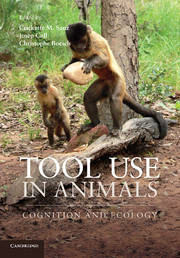Book contents
- Frontmatter
- Contents
- List of contributors
- Part I Cognition of tool use
- Part II Comparative cognition
- Part III Ecology and culture
- Part IV Archaeological perspectives
- 11 From pounding to knapping: How chimpanzees can help us to model hominin lithics
- 12 Early hominin social learning strategies underlying the use and production of bone and stone tools
- 13 Perspectives on stone tools and cognition in the early Paleolithic record
- Index
- References
11 - From pounding to knapping: How chimpanzees can help us to model hominin lithics
from Part IV - Archaeological perspectives
Published online by Cambridge University Press: 05 March 2013
- Frontmatter
- Contents
- List of contributors
- Part I Cognition of tool use
- Part II Comparative cognition
- Part III Ecology and culture
- Part IV Archaeological perspectives
- 11 From pounding to knapping: How chimpanzees can help us to model hominin lithics
- 12 Early hominin social learning strategies underlying the use and production of bone and stone tools
- 13 Perspectives on stone tools and cognition in the early Paleolithic record
- Index
- References
Summary
Are pounding tools the missing link for the origins of technology?
All populations of modern humans (Homo sapiens) have repertoires of tool use and tool making (e.g., Ambrose, 2001). All well-studied extant populations of chimpanzees (Pan troglodytes) have repertoires of tool use and tool making (e.g., McGrew, 1992, 2010; Whiten et al., 1999; Sanz et al., 2010). No other living primate has lengthier inventories of tools than humans and chimpanzees (see van Schaik et al., 2003; Ottoni & Izar, 2008; Gumert et al., 2009 for inventories of tools in Pongo pygmaeus, Cebus spp. or Macaca fascicularis). During the Early Pleistocene, populations of hominins living in East and South Africa most likely had wider tool-use repertoires than the ones we have currently identified, which are only the non-organic, that is, non-perishable ones. Thus, archaeologists are mainly left with stone tools and fossilized bones to reconstruct the tool-use repertoire of the earliest hominins (e.g., Semaw et al., 2003; Plummer, 2004). In West Africa, for at least 4300 years, chimpanzees have been using stone tools, namely hammers and anvils, to access the kernels of hard-shelled nuts (Mercader et al., 2007).
Since studies began at Olduvai Gorge, Tanzania, and Koobi Fora, Kenya, stone tools have played a crucial role in inferring the evolution of early hominin behavior, beginning with research on the earliest stone tool industries (Leakey, 1971; Isaac, 1984). Leakey’s typological approach to the Oldowan was based on a continuous sequence of artifacts corresponding to the succession of cultures identified through the Olduvai stratigraphy. Metrics and types were applied to categorize lithics, to provide relative timelines and to make comparisons across industries/assemblages (mainly the Oldowan from Olduvai and KBS from Koobi Fora). In the 1980s lithic studies progressed, as artifacts needed to be understood and described in contexts, as they represent only one part of the hominin activity budget (Isaac, 1981). Isaac inspired a new research direction: integration of lithic studies into a paleoecological approach. This interdisciplinary approach aimed to get closer to site-formation processes and functions, and to understand ranging patterns in hominins (Isaac & Harris, 1997). Isaac (1984, 1986) also proposed an alternative terminology to describe the earliest stone assemblages. All artifacts were placed into three main categories (flaked, detached, pounded) with the aim of finding a simple alternative to terminologies based on post hoc, function-inferred labels (Leakey, 1971).
- Type
- Chapter
- Information
- Tool Use in AnimalsCognition and Ecology, pp. 225 - 241Publisher: Cambridge University PressPrint publication year: 2013
References
- 6
- Cited by



